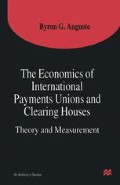Abstract
In the last two chapters, we assessed the importance of the savings of international reserves and trade creation which the European Payments Union generated in OEEC Europe in the 1950s. In this chapter, we attempt to quantify the impact of these two beneficial effects on the region’s aggregate income and medium-term rate of economic growth. In Section 11.1 we consider the assessment offered by the neoclassical growth accounting literature — exemplified by Denison (1967) — of the contribution of trade and payments liberalization to economic growth in OEEC Europe. In Section 11.2 we estimate the impact effect of the EPU on OEEC Europe’s aggregate income, based on our estimates of reserve savings and trade creation from Chapters 9 and 10. In Section 11.3 we estimate the size of the capital accumulation effect of the EPU on regional income, given three different estimates of the elasticity of aggregate output with respect to capital, each corresponding to a different model of economic growth. In Section 11.4 we examine the distinction between the Union’s effect on regional income and on regional economic growth. For the purpose of comparison, we present our estimates of the income effects of the EPU in terms of the growth effects of the growth accounting literature.ω
Access this chapter
Tax calculation will be finalised at checkout
Purchases are for personal use only
Preview
Unable to display preview. Download preview PDF.
Notes
Depreciation averaged 12.4 per cent of OEEC European GNP in 1950–8. We obtain data on real GNP and gross capital formation in comparative form in OEEC General Statistics Bulletin (1960). Denison (1967, 414–28) estimates the net capital stock for eight OEEC countries, whose total share of regional GNP averaged 85 per cent in 1950–8. Comparing annual changes in OEEC Europe’s net capital stock to annual gross investment yields estimates of depreciation. Subtracting depreciation from GNP yields the net national product, which is our estimated value of Y. We estimate the net capital stock of OEEC Europe as a whole by assuming that the countries generating the remaining 15 per cent of GNP have the same capital-output ratio as the eight countries for which we use Denison’s estimates. This procedure yields our estimate of K. By this method, we estimate OEEC Europe’s average capital-output ratio as 1.36 in 1950–8.
Copyright information
© 1997 Byron G. Auguste
About this chapter
Cite this chapter
Auguste, B.G. (1997). The Impact of the EPU on Income and Economic Growth. In: The Economics of International Payments Unions and Clearing Houses. St Antony’s Series. Palgrave Macmillan, London. https://doi.org/10.1007/978-1-349-25517-7_12
Download citation
DOI: https://doi.org/10.1007/978-1-349-25517-7_12
Publisher Name: Palgrave Macmillan, London
Print ISBN: 978-1-349-25519-1
Online ISBN: 978-1-349-25517-7
eBook Packages: Palgrave Economics & Finance CollectionEconomics and Finance (R0)

